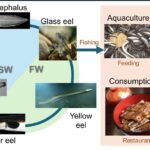EUMOFA has published a new Price Structure Analysis on “Smoked eel in the EU”. The study analyses eel production and market trends in the EU, with a special focus on three key markets: the Netherlands, Germany, and Denmark.
IN BRIEF
Between 2009 and 2018, EU production of eel decreased by 19%. In 2018, EU production accounted for 3% of global production, whereas China – the world’s largest producer – accounted for 84%, producing mainly Japanese eel.
However, as the world’s main producer of European eel, the EU accounted for 94% of global production of the species in 2018.
Eel in the EU is mainly produced via aquaculture (68%) and, to a lesser extent, fisheries. The Netherlands, Germany, and Denmark are the main EU producers of eel, each registering over 600 tonnes of production in 2018.
THE DUTCH MARKET
The Netherlands is the largest provider of eel in the EU. Both fisheries and aquaculture sectors have grown since 2012. Two thirds from the total eel supply (production+imports) in the country were estimated as national “apparent” consumption of live weight equivalent (lwe) in 2018. The rest was exported. Smoked eel is a traditional food in the Netherlands, and is considered to be a premium product. It is consumed both as fillets and whole, with demand for fillets higher than that for whole eel.
Smoked eel fillets are generally sold in 100g packages and the price ranges from 5,00 to 7,00 EUR/100g, but some products are retailed up to 8,00 EUR/100g.
THE GERMAN MARKET
Germany is the second largest market for eel in the EU, after the Netherlands. Eel production in the country increased significantly between 2012 and 2018 (+97%), due to a strong growth in aquaculture capacity (+167%). In 2018, about 65% from the total supply (production+imports) in Germany was estimated as national “apparent” consumption of live weight equivalent (lwe). The remaining 35% were exported. Demand for smoked eel prevails as it is considered a delicacy, consumed mainly in December. The highest demand is for whole smoked products (300-500g, 600-800g, and >800g), but also fillets and, less often, steaks. The retail price of whole smoked eels was roughly 49,00 EUR/kg in March 2020.
THE DANISH MARKET
Production of eel in Denmark decreased by 55% between 2012 and 2018. This fell to 623 tonnes in 2018, and was dominated by production from aquaculture. National production accounted for 70% of the total supply of eel in 2018. The remaining supply was imported. Almost three quarters (73%) of supply was exported, thus national “apparent consumption” accounted for roughly a quarter of live weight equivalent (lwe). Consumption of smoked eel is traditional in Denmark. The consumer price for smoked eel ranges from 38,00 to 67,00 EUR/kg and is usually sold in packages of 300-400g.
Stay Always Informed
Join our communities to instantly receive the most important news, reports, and analysis from the aquaculture industry.
Reference (open access):
EUMOFA. 2021. CASE STUDY: SMOKED EEL IN THE EU. PRICE STRUCTURE IN THE SUPPLY CHAIN. FOCUS ON THE NETHERLANDS, GERMANY AND DENMARK. 41 p.
Editor at the digital magazine AquaHoy. He holds a degree in Aquaculture Biology from the National University of Santa (UNS) and a Master’s degree in Science and Innovation Management from the Polytechnic University of Valencia, with postgraduate diplomas in Business Innovation and Innovation Management. He possesses extensive experience in the aquaculture and fisheries sector, having led the Fisheries Innovation Unit of the National Program for Innovation in Fisheries and Aquaculture (PNIPA). He has served as a senior consultant in technology watch, an innovation project formulator and advisor, and a lecturer at UNS. He is a member of the Peruvian College of Biologists and was recognized by the World Aquaculture Society (WAS) in 2016 for his contribution to aquaculture.



